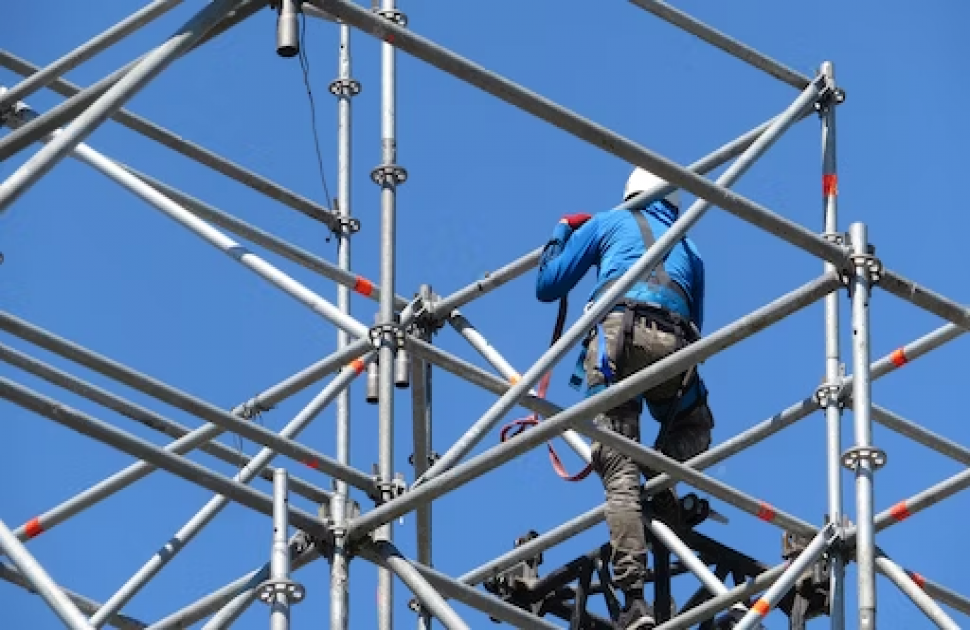Table Of Contents
- Introduction
- Components of Scaffolding
- Scaffolding Materials
- Scaffolding Types
- General Scaffolding Requirements
- Uses of Scaffolding
- Scaffolding Rental vs. Purchase
- Conclusion
- Key Takeaways
Introduction
Scaffolding is a vital component in the world of construction and Non-Destructive Testing (NDT).
In basic terms, scaffolding refers to temporary structures designed to support the existing structure while providing a secure platform for workers and materials during construction endeavors.
These scaffolds come in various forms, including both supported and suspended varieties, each tailored to specific construction needs.
Components of Scaffolding
A well-constructed scaffold in civil engineering comprises several key components to ensure safety, stability, and functionality.
The major components of a perfect scaffold typically include:
- Standards or Vertical Members
These are vertical Pipelines or tubes that serve as the main load-bearing elements, supporting the scaffold's weight and transferring it to the ground or a suitable foundation.
- Ledgers or Horizontal Members
The horizontal tubes or pipes that connect the standards horizontally, and provide lateral stability to the scaffold structure are called ledgers.
- Transoms
Transoms are horizontal members that connect the ledgers and support scaffold boards or planks on which workers stand or materials are placed.
- Scaffold Boards or Planks
These are the working platforms where construction workers stand and perform their tasks. They should be sturdy, secure, and regularly inspected for safety.
- Diagonal Braces
Diagonal braces help to stabilize the scaffold by preventing lateral movement and ensuring the scaffold remains rigid and secure.
- Base Plates
Base plates are placed at the bottom of each standard to distribute the scaffold's load evenly and provide stability on the ground or foundation.
- Sole Plates
Sole plates are used to distribute the load from the base plates and protect the ground or surface on which the scaffold is erected.
- Guardrails and Toeboards
These safety components are essential to prevent falls and protect workers from accidents while working on the scaffold.
- Couplers and Fittings
Couplers and fittings are used to connect and secure scaffold components, ensuring the scaffold's integrity and stability.
- Tie-in and Anchorage Points
These are attachments or connections to adjacent structures or other scaffolding components and enhance stability and safety.
- Access Ladders and Stairs
These provide a safe means for workers to access the scaffold at different levels, ensuring convenience and safety.
- Safety Netting and Fall Arrest Systems
Depending on the height and complexity of the scaffold, additional safety measures like safety nets and fall arrest systems are installed to protect workers from falls.
- Load-Bearing Capacity
It's crucial to ensure that the scaffold has the necessary load-bearing capacity to support not only workers but also construction materials and equipment.
- Regular Inspection and Maintenance
Regular Inspection and maintenance are essential to identify and address any issues promptly, ensuring the scaffold remains safe and functional throughout the construction project.
Scaffolding Materials
Scaffolding can be constructed using a variety of materials, and the choice often depends on factors such as the type of construction project, budget, safety requirements, local regulations, and the environment in which it will be used.
Common materials used in scaffolding include:
- Steel
Steel scaffolding is known for its strength and durability.
It's commonly used in heavy-duty construction projects due to its load-bearing capacity.
Tubular steel scaffolding is a popular choice in construction sites.
- Aluminum
Aluminum scaffolding is lightweight and Corrosion-resistant.
It's suitable for both indoor and outdoor applications and is often preferred for projects where quick assembly and mobility are essential.
- Wood
Wood has been used for scaffolding historically and is still employed in some cases, especially for smaller-scale projects.
Wooden scaffolding planks are often used in combination with metal or wood framing.
- Bamboo
Bamboo is utilized for scaffolding since it is lightweight, strong, and plentily available.
It is significantly lighter than other materials such as steel, and aluminium, and it can be constructed and removed much faster than steel or aluminium scaffolding.
- Fiberglass
Fiberglass scaffolding is Corrosion-resistant and electrically non-conductive, making it a safe choice for projects near electrical hazards.
It's also lightweight and easy to handle.
- Plastic
Plastic scaffolding is lightweight, corrosion-resistant, and easy to transport.
It is often used for light-duty or residential projects.
- Composite
Composite scaffolding combines materials like fiberglass and plastic for a balance of strength, durability, and corrosion resistance. It's a versatile choice for various applications.
- Bamboo and Timber Mix
In regions with a strong tradition of using bamboo, scaffolding often incorporates a mix of bamboo and timber for cost-effectiveness and reliability.
Scaffolding Types
Different types of scaffolding systems are used around the world.
Here are the top 10 types of scaffolding commonly used nowadays.
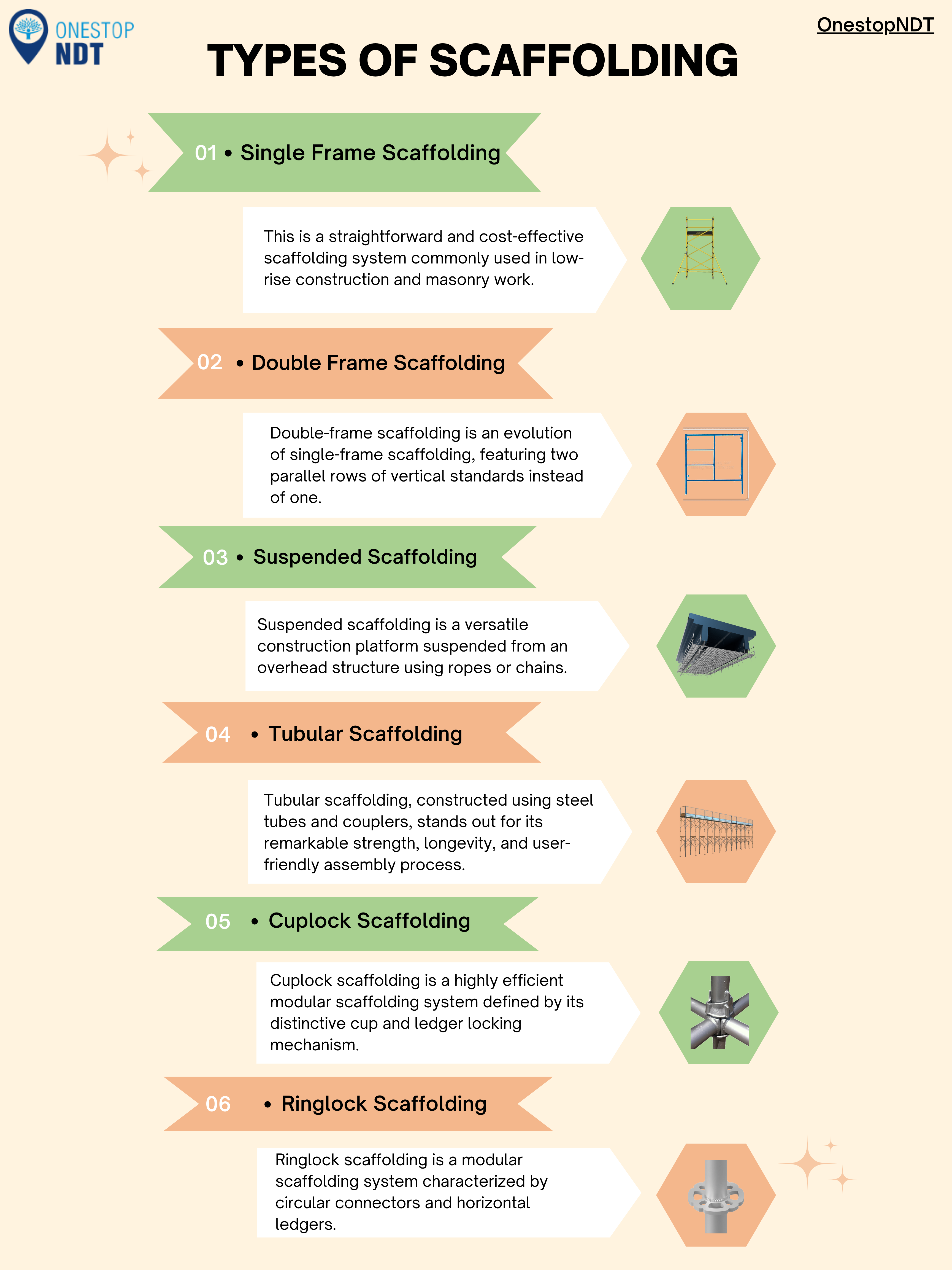
- Single Frame Scaffolding
Single-frame scaffolding is often referred to as bricklayer scaffolding.
This is a straightforward and cost-effective scaffolding system commonly used in low-rise construction and masonry work.
Its design comprises vertical standards securely anchored into the ground, with horizontal ledgers and transoms forming a single, stable frame.
Single frame scaffold is known for its ease of assembly and dismantling. However, it has limitations in terms of height, and stability diminishes as additional frames are stacked.
Single-frame scaffolding is an efficient choice for smaller projects but may not be suitable for larger or taller structures due to its height constraints and reduced stability with increased height.
- Double Frame Scaffolding
Double-frame scaffolding is an evolution of single-frame scaffolding, featuring two parallel rows of vertical standards instead of one.
This design significantly enhances stability and load-bearing capacity, making it well-suited for more substantial construction tasks like plastering and concrete work.
The dual rows of standards provide robust support, ensuring a secure platform for workers and materials, even at greater heights.
Double-frame scaffolding is credited for its versatility, making it suitable for a wide range of applications.
Its capacity to handle heavier loads and maintain stability at increased heights makes it a preferred choice for demanding construction projects, where safety and strength are crucial.
- Suspended Scaffolding
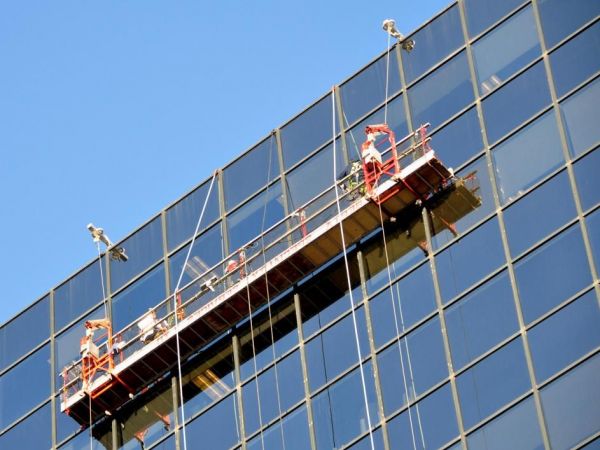
Suspended scaffolding is a versatile construction platform suspended from an overhead structure using ropes or chains.
This type of scaffolding is especially valuable for tasks requiring vertical access to exterior building surfaces, such as window cleaning, painting, or maintenance on tall structures.
Suspended scaffolds offer an adjustable working platform, enabling workers to efficiently maneuver up and down the building's facade.
Safety is paramount when using suspended scaffolding, and necessitates the implementation of fall arrest systems and other protective measures to safeguard workers operating at significant heights.
The flexibility and precision of suspended scaffolding enhance productivity in high-rise construction and maintenance projects.
- Tubular Scaffolding
Tubular scaffolding, constructed using steel tubes and couplers, stands out for its remarkable strength, longevity, and user-friendly assembly process.
This versatile scaffold system suits a wide range of construction projects, offering secure and stable working platforms at various elevations.
Its reputation for reliability and robustness has made it a staple in the construction industry, finding application in industrial, commercial, and residential settings.
- Cuplock Scaffolding
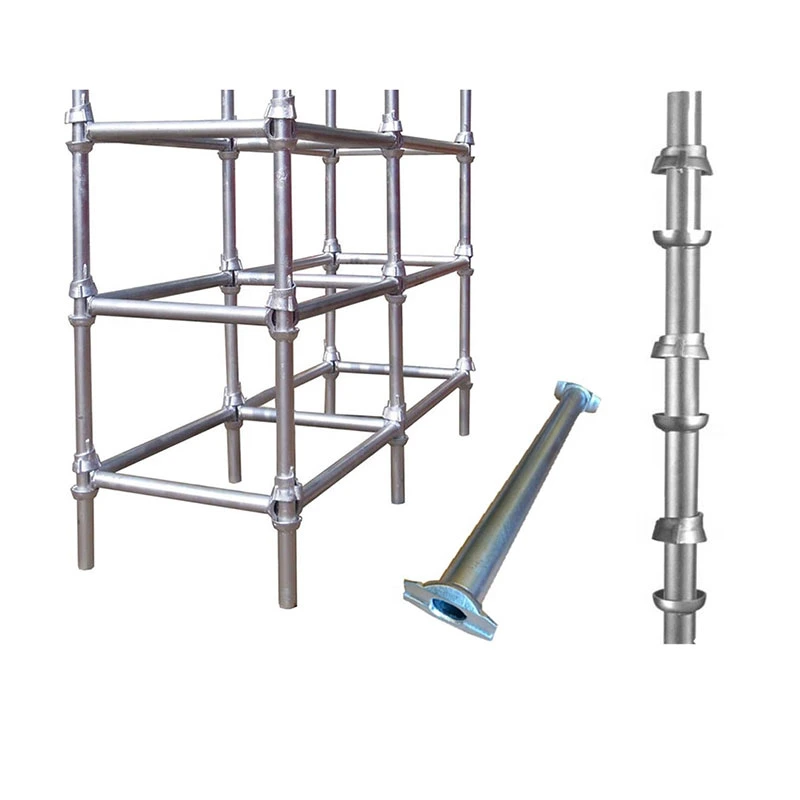
Cuplock scaffolding is a highly efficient modular scaffolding system defined by its distinctive cup and ledger locking mechanism.
Its rapid assembly and disassembly, make it ideal for projects with stringent timeframes.
Cuplock scaffolding is renowned for its exceptional load-bearing capacity, capability to support heavy loads and adaptability to intricate and complex construction structures.
This versatility, combined with its strength and stability, positions it as a top choice for large-scale construction endeavours.
It's particularly valuable in situations where efficiency and robust support are critical factors for project success, making it a favoured scaffolding system in the construction industry.
- Ringlock Scaffolding
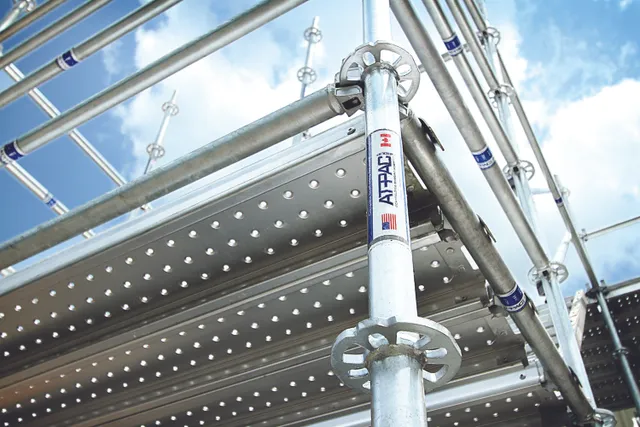
Ringlock scaffolding is a modular scaffolding system characterized by circular connectors and horizontal ledgers.
Its reputation lies in its exceptional versatility, rapid assembly, and unwavering stability.
This scaffold system excels in adapting to diverse construction scenarios, whether industrial, commercial, or residential, making it a go-to choice for many applications.
What sets ring lock scaffolding apart is its capability to offer secure work platforms even on uneven terrain, addressing one of the most challenging aspects of construction.
The combination of flexibility and robust support makes ring lock scaffolding a favored option in the construction industry, enhancing efficiency and safety in various project environments.
- H-Frame Scaffolding
H-frame scaffolding comprises H-shaped frames and cross-braces, forming a simple and easy-to-assemble scaffolding system.
It is well-suited for tasks such as painting, plastering, and minor repair work.
While H-frame scaffolding may not reach the heights or offer the load-bearing capacity of more intricate scaffold systems, it remains a cost-effective choice for smaller-scale projects.
Its uncomplicated design and quick setup make it a practical option when both efficiency and simplicity are paramount.
This type of scaffold serves as a reliable and budget-friendly solution for construction and maintenance tasks that do not demand extensive elevation or heavy-duty support.
- Kwikstage Scaffolding
Kwikstage scaffolding stands out as a versatile scaffold system using pre-fabricated components that securely interlock through wedge clamps, enabling swift assembly and disassembly.
This adaptability makes it well-suited for diverse applications, even on uneven ground, thanks to its adjustable legs.
Kwikstage scaffolding shines in projects with evolving needs, as its modular design easily accommodates changing requirements.
Its flexibility and ease of use make it a preferred choice in construction, where efficiency and adaptability are crucial.
Whether for maintenance, construction, or renovation, Kwikstage scaffolding offers a dependable and convenient solution to meet a wide range of project demands.
- Bamboo Scaffolding
In some regions, bamboo scaffolding remains prevalent due to its strength and flexibility. It is commonly used in areas with a rich tradition of bamboo craftsmanship.
Bamboo scaffolding is lightweight, cost-effective, and eco-friendly, making it suitable for low-rise construction projects and maintenance work. It offers stability and safety when properly erected and secured.
Each type of scaffolding has its unique characteristics and applications, and the choice depends on factors such as the type of construction, budget, accessibility, and safety requirements.
Selecting the appropriate scaffolding system is crucial to ensure worker safety and the efficient completion of construction projects.
General Scaffolding Requirements
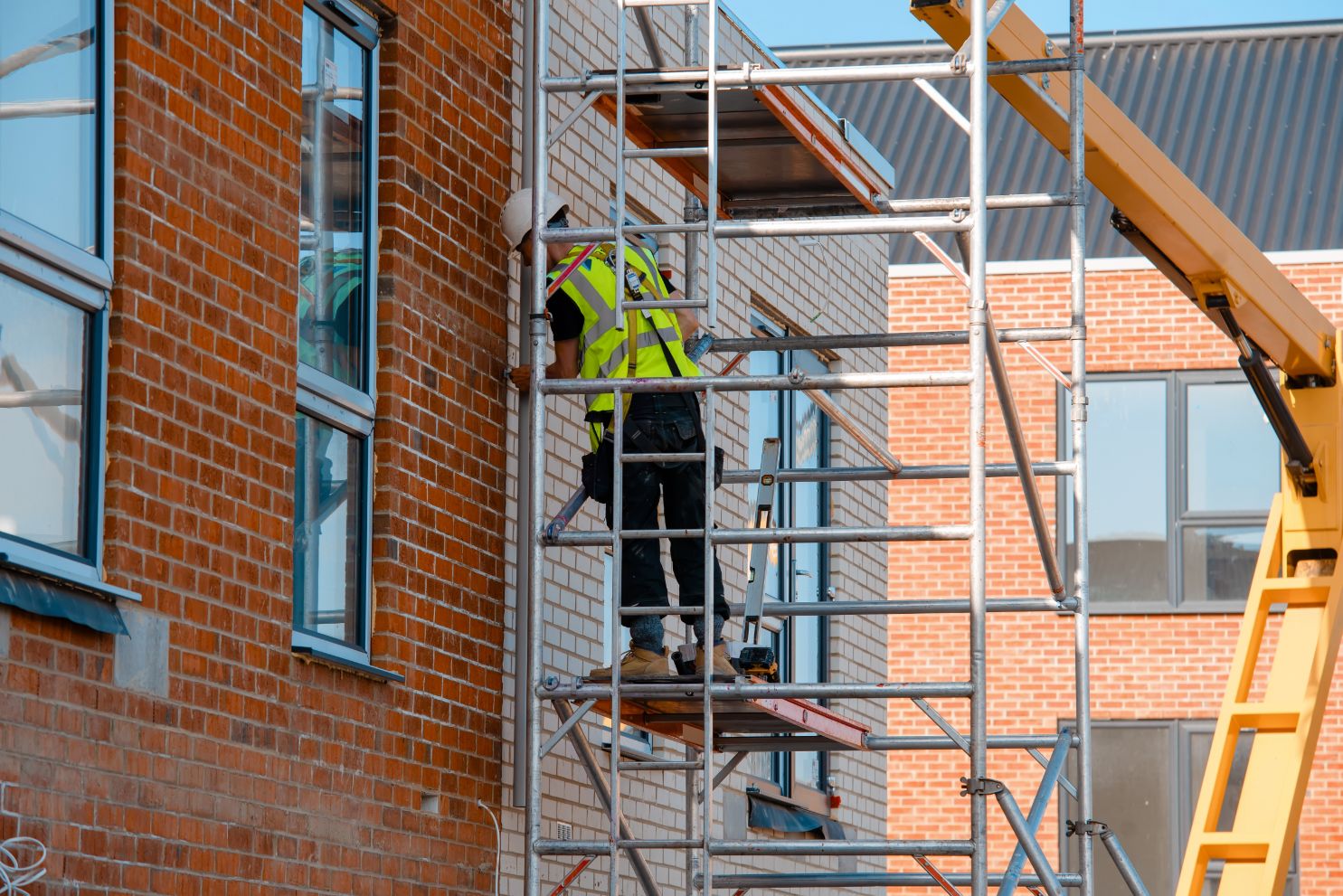
General scaffolding requirements encompass a set of guidelines and safety measures that must be adhered to when designing, erecting, and using scaffolding in construction and maintenance activities.
These requirements are essential to ensure the safety of workers, protect the integrity of the scaffold, and maintain the efficiency of the work site.
Essential general scaffolding requirements include:
- Competent Personnel
Scaffolding should be designed, erected, and inspected by trained and qualified personnel to ensure safety standards.
- Scaffold Design
Scaffolding design should consider the specific project's needs, load-bearing capacity, and structural stability.
- Foundation
Scaffolds must be erected on a stable, level, and load-bearing surface.
The foundation should be capable of supporting the scaffold's weight, workers, and materials.
- Guardrails and Toeboards
Guardrails and toeboards should be installed on all open sides and ends of the scaffold to prevent falls and protect workers.
- Access
Safe access to the scaffold should be provided through ladders, staircases, or other approved means.
- Platform Strength
Scaffold platforms (boards or planks) should be capable of supporting the intended load without excessive deflection or sagging.
- Fall Protection
Fall protection systems, such as personal fall arrest systems or safety nets, should be in place for workers at heights exceeding certain thresholds.
- Regular Inspection
Scaffolding should be inspected regularly by competent personnel to identify and address any defects or issues promptly.
- Load Capacity
The scaffold should have a clearly defined load capacity, and workers should not exceed this limit.
- Clearance Zones
Adequate clearance zones should be maintained between the scaffold and power lines, machinery, or other hazards to ensure safe working conditions.
- Stability
The scaffold should remain stable during use, and diagonal braces or tie-ins may be required to enhance stability.
- Weather Considerations
Scaffolds should be secured in windy conditions, and snowy or icy platforms should be cleared to prevent slips and falls.
- Documentation
Records of scaffold inspections, assembly, and dismantling should be maintained for safety compliance.
- Training
Workers using scaffolding should receive proper training in scaffold safety, including how to erect, use, and dismantle scaffolds safely.
- Fall Arrest Systems
Workers should wear appropriate fall arrest systems when working on scaffolds at certain heights.
- Egress
Adequate means of escape, such as additional scaffolding bays or ladders, should be provided for emergency evacuation.
- Proper Storage
Materials and equipment should be stored on the scaffold in an organized and secure manner to prevent accidents.
These general scaffolding requirements serve as a foundation for safe scaffold use, and they may indirectly be related to Non-destructive Testing.
Compliance with these requirements is essential to minimize the risk of accidents and injuries on construction sites.
Uses of Scaffolding
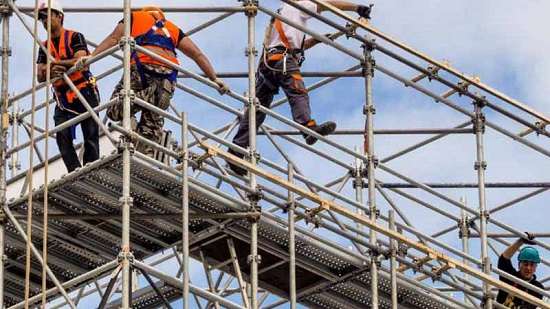
Scaffolding serves a wide range of applications in the construction and maintenance industries, providing a secure and elevated platform for workers and materials.
Some common applications of scaffolding include:
- Building Construction
Scaffolding is extensively used in the construction of buildings, both residential and commercial.
It allows workers to access various levels of the structure, facilitating tasks like bricklaying, plastering, painting, and window installation.
- Bridge Construction
Scaffolding is crucial in the construction and maintenance of bridges, providing access to hard-to-reach areas for inspection, repair, and construction work.
- Non-Destructive Testing
Non-destructive Testing serves as a crucial advantage in the context of scaffolding, offering several benefits in terms of safety, efficiency, and cost-effectiveness.
Scaffolding is a temporary structure erected to support workers and materials during the construction, maintenance, or repair of buildings and other structures.
NDT techniques, such as Ultrasonic Testing, radiographic testing, and magnetic particle testing, help ensure the structural integrity of scaffolding components.
- Industrial Maintenance
Industries such as manufacturing, petrochemical, and power generation use scaffolding for routine maintenance and repairs of equipment, machinery, and infrastructure.
- Shipbuilding and Repair
Scaffolding is utilized in shipyards for the construction and maintenance of ships and vessels, including Sandblasting, painting, and welding tasks.
- Tunnel Construction
In tunnelling projects, scaffolding is employed for tunnel lining installation, ventilation system maintenance, and other tasks requiring elevated access.
- Facade and Exterior Work
Scaffolding is used for exterior building maintenance, including cleaning, painting, and the installation of cladding or insulation materials.
- Roofing and Gutter Work
Roofers use scaffolding for safe access when repairing or replacing roofs, gutters, and chimneys.
- Demolition
Scaffolding provides a secure platform for workers involved in building demolition, allowing them to dismantle structures in a controlled manner.
- Event Staging
Scaffolding is used in the entertainment industry for creating temporary stages, grandstands, and viewing platforms for events such as concerts, festivals, and sports matches.
- Film and Photography
In the film and photography industry, scaffolding structures are used to position cameras, lighting equipment, and crew for aerial shots and capturing unique angles.
- Access to Confined Spaces
Scaffolding is valuable in providing safe access to Confined Spaces like tanks, silos, and underground tunnels.
- Historical Restoration
When restoring historical buildings and landmarks, scaffolding is employed to access and repair intricate architectural details.
- Mining
In mining operations, scaffolding is used for maintenance and repair work on mining equipment and infrastructure.
- Rescue Operations
Scaffolding can be adapted for use in emergency rescue operations, providing access to victims in difficult-to-reach locations.
Scaffolding plays a crucial role in enhancing worker safety, enabling efficient work at heights, and ensuring the successful completion of a wide range of construction, maintenance, and access-related tasks across various industries.
Scaffolding Rental vs. Purchase
The decision to rent or buy scaffolding is ultimately determined by the needs of the project.
Renting scaffolding may be the best solution for a short-term project and reusing it in the near future isn’t anticipated.
Scaffolding rental can save a lot of money while still getting the benefits of high-quality equipment as and when needed.
Not only that but renting scaffolding eliminates the burden of storing and maintaining the equipment once the project is completed.
However, for a long-term project that will necessitate the use of scaffolding for a lengthy period, buying scaffolding may be the most cost-effective option in the long run.
Of course, there are other aspects to consider besides duration, such as the kind of scaffolding required and the budget.
Conclusion
Scaffolding is an indispensable tool in the world of construction and maintenance.
Its versatile applications, whether in building construction, industrial maintenance, or event staging, underscore its significance in providing safe access to elevated work areas.
Scaffolding not only ensures the safety of workers but also enhances efficiency and productivity on job sites.
It adapts to diverse construction environments, from towering skyscrapers to historical landmarks, and remains an essential component in the toolkit of industries worldwide.
As technology continues to advance, scaffolding systems evolve, but their core purpose remains unchanged: to support progress, enable access, and safeguard those who build our world.
Key Takeaways
- Scaffolding is a temporary structure providing a safe platform for workers and materials during construction.
- Components of scaffolding include standards, ledgers, transoms, scaffold boards, diagonal braces, base plates, safety features, and more.
- Various materials like steel, aluminum, wood, bamboo, and others are used in scaffolding based on project requirements.
- There are different types of scaffolding systems, each suited for specific applications and construction needs.
- General scaffolding requirements ensure the safety, stability, and functionality of scaffolding structures.
- Scaffolding is widely used in construction, bridge building, industrial maintenance, Non-destructive Testing shipbuilding, tunnelling, and more.
- The choice between renting and buying scaffolding depends on project duration and specific needs.
References
1. Scaffold Pole
2. Scaffold
3. At PAC
